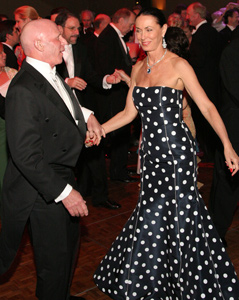Fun with Numbers
Most of us will never know what it is like to be a Warren Buffett or Bill and Melinda Gates and experience the feeling of donating millions of dollars to charitable causes. But learning about what motivates major donors like them to give, can help us better shape our own donor experience. Here in Texas, we have our fair share of philanthropists who give substantial amounts of money to various causes – and some aren’t shy about sharing their motivations with us. Two shining and very different examples are John and Laura Arnold, and Lester Smith.
John and Laura Arnold
On August 14, 2012, the Laura and John Arnold Foundation launchedGiving Library; a website designed to provide prospective donors with objective information about a variety of nonprofits in order to help them make “informed and impactful” decisions about their giving. The idea grew out of their own frustration when attempting to make sound donation choices. A former hedge fund manager and attorney, the Arnolds’ approach to philanthropy is strategic: they look to “invest” their funds in nonprofits that have proven sustainability and can leverage those funds to obtain even more funding, thereby maximizing their impact. However, the couple found it difficult and time-consuming to obtain adequate information for making decisions. More often than not, it required a trip to the charity’s location in order to ask its founder in-depth questions about the organization face-to-face. While doing so, they realized that others, who were not at liberty to make such trips, could still benefit from their research.
Like many donor-advised websites, Giving Library posts information about over 100 nonprofits* (see below) that have been vetted by the foundation. However, what you see are not promotional videos, but one-on-one interviews with the nonprofits’ leaders. To make a fair comparison, all of them are asked the same 10 key questions including: “What are the leverage points that will make your organization successful?” and “What are the metrics of success for your organization?” As a prospective donor, you get to look them in the eye, so to speak, feel their passion, and assess their vision and ability to attain it, for yourself. To take the process even further, you are encouraged to contact the nonprofit directly through the website’s ‘Connection Center’ to ask even more questions or request information. This feature enables you to reach out to nonprofits anonymously, if you wish. The Giving Library’s six focus areas include causes that are especially significant to the Arnolds: Criminal Justice, Education, Environmental, Governmental, Health, and Humanitarian.
What can be said about Lester Smith… that he hasn’t already said about himself? The subtitle to his book, You Gotta Dance Like No One’s Watching, is “A two-time cancer survivor and two-time national ballroom dance champion takes life for a spin.” And that says it all. Lester inherited his generous heart from his father, who modeled philanthropy to his two sons from the beginning although, as he says, his dad wasn’t aware he was doing so at the time. It was just something that one did because it was the right thing to do. “There was always room for one more at the dinner table, and sometimes two or three. There was always a family to support, a child to clothe, a job to be given.”
Lester and Sue Smith "going for a spin"
Though Lester has made charitable donations all his life either through his foundation, his incredibly successfulPink Well Challengeor on a personal level, being a two-time cancer survivor means that now Lester gives the same way he does everything else in his life: passionately. Being near to death not once, but twice, has caused him to realize that doing anything that isn’t fun, is a waste of precious time. Yet how does a charity make giving fun for its major donors? One way is by offering them an opportunity to connect directly with recipients, whenever possible. Then donors can witness the smiles on children’s faces when they receive a backpack full of new school supplies, or the relief of parents whose children are able to receive life-saving medical treatment despite the cost.
These two approaches may seem disparate, but they hinge on the same principal: connectivity between the donor and the nonprofit. Gen X and Y donors (both Laura and John Arnold are in their late 30s) approach donating the same way that they approach investing: through in-depth, primarily web-based research. Therefore nonprofits should make certain to have all of their pertinent information up-to-date and available on their websites (audited financials, Form 990s, and Donor’s Bill of Rights). In addition, nonprofit leaders should make sure that they know the answers to all 10 of the questions being asked on the Giving Library website. Lastly, don’t get so caught up in fundraising goals and deadlines that you lose sight of the JOY of giving. If you want to keep your major donors year after year, try to find a way to make giving to your organization fun!
* NOTE: Phase I of Giving Library included 250 nonprofits. Phase II opened in 2013, when taping began in order to increase the number by an additional 600 nonprofits.


